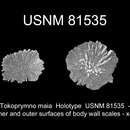pt-BR
nomes no trilho de navegação


“34. Tokoprymno Bayer, 1996
FIGURE 15O–U
Tokoprymno Bayer, 1996a:511.
Diagnosis. Colonies bushy and irregularly dichotomous in branching. Calyces arranged biserially, projecting perpendicularly from opposite edges of each branch; brood polyps common. Well-developed operculum present (Figure 15o) unless the brood polyp has released its planulae, in which case operculars are lost (Figure 15q); operculars keeled (Figure 15u) on inner surface. Eight marginal scales have straight to rounded distal edges that do not fold over operculum. Polyp completely protected by eight rows of body wall scales. Most scales bear short, radiating ridges (Figure 15s–t) on their outer surface. Coenenchymal scales arranged in one layer.
Discussion. The genus is monotypic (Table 4) and known from only one locality.
Distribution. The type locality, an unnamed seamount in the subantarctic South Pacific seamount (549 m), is a deepwater coral bank formed by the scleractinian Solenosmilia variabilis and is known to host a large diversity of invertebrate fauna (Cairns, 1982a, 1982b).
Type Species. T. maia Bayer 1996, by original designation. The holotype is deposited at the USNM (81535).”
(Bayer & Cairns, 2009)
“Tokoprymno, new genus
Diagnosis.—Irregularly branched Primnoidae with polyps more or less biserial but not in pairs, directed toward one side of the branches. Vegetative polyps tall, straight, somewhat wider distally; operculum conical, usually very prominent when closed; marginal scales 8, nearly equal in size, directly aligned with operculars; body scales aligned in spirals; brood polyps ovate, losing opercular scales upon discharge of planulae.
Type Species.—Tokoprymno maia, new species.
Etymology. Greek τοκος, birth + Prymno, one of the Oceanids, in allusion to the conspicuous brood polyps. Gender feminine.
Remarks.—In Kükenthal’s (1924) arrangement of primnoid subfamilies, this genus falls into the Callozostrinae, which have vertically placed polyps not bent inward toward the axis. In that subfamily, the only genus having any similarity to Tokoprymno is Parastenella Versluys, 1906, which also has eight marginal scales. However, in that genus the marginal scales alternate with the operculars and have a marginal point or spine, whereas in Tokoprymno the marginals are aligned with the operculars and have no marginal spine.
Although octocorals in general have been considered oviparous, a number of species have been found to brood their eggs through the early stages of development and produce larvae well advanced at birth (Thomson and Henderson 1906a: 504; 1906b: viii). Three species of Gorgonacea are among those recorded by Thomson and Henderson, none of them belonging to the family Primnoidae.”
(Bayer, 1996)
Tokoprymno is een geslacht van neteldieren uit de klasse van de Anthozoa (bloemdieren).
Tokoprymno is een geslacht van neteldieren uit de klasse van de Anthozoa (bloemdieren).